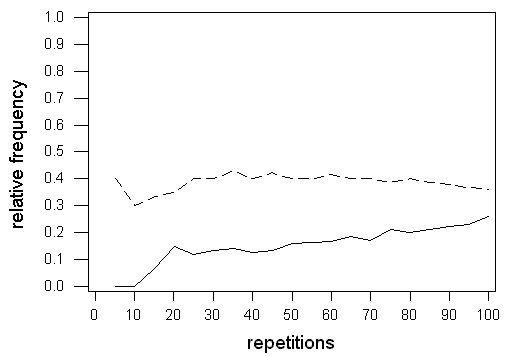
(e) The proportion of trials where Johnson matches appears to be approaching .25. The proportion with no matches appears to be aproaching .35.
(f)
|
|
|
|
|
|
|
|
|
|
|
|
|
|
|
|
|
|
|
|
|
|
|
|
|
|
|
|
(c)
|
|
|
Johnson
|
|
? |
All
|
|
? |
|
|
|
|
|
|
|
||
|
|
|
|
|
|
|
|
|
|
|
|
|
|
|
|
|
|
|
|
|
|
|
|
|
|
|
|
|
|
|
|
|
|
|
|
|
|
|
|
|
|
|
|
|
|
|
|
|
|
|
|
|
|
|
|
|
|
|
|
|
|
|
|
|
|
|
|
|
|
|
|
|
|
|
|
|
|
|
|
|
|
|
|
|
|
|
|
|
|
|
|
|
|
|
|
|
|
|
|
|
|
|
|
|
|
|
|
|
|
|
|
|
|
|
|
|
|
|
|
|
|
|
|
|
|
|
|
|
|
|
|
|
|
|
|
|
|
|
|
|
|
|
|
|
|
|
|
|
|
|
|
|
|
|
|
|
|
|
|
|
|
|
|
|
|
|
|
|
|
|
|
|
|
|
|
|
|
|
|
(d)
(e) The proportion of trials where Johnson matches appears to be approaching
.25. The proportion with no matches appears to be aproaching .35.
(f)
|
|
|
|
|
|
|
|
|
|
|
|
|
|
|
|
|
|
|
|
|
|
|
|
(g) .65
(h) empirical probability of no matches =.35
(i) empirical probability of at least one match=.65
(j) An outcome of exactly three matches is impossible because if 3
are correct, then the last position must be correct since there are only
4 possibilities to begin with.
(k) It is not impossible to get four matches, but it is rare.
(l) A result of 0, 1, or 2 matches is not unlikely.
| 1234: 4 | 1243: 2 | 1324: 2 | 1342: 1 | 1423: 1 | 1432: 2 |
| 2134: 2 | 2143: 0 | 2314: 1 | 2341: 0 | 2413: 0 | 2431: 1 |
| 3124: 1 | 3142: 0 | 3214: 2 | 3241: 1 | 3412: 0 | 3421: 0 |
| 4123: 0 | 4132: 1 | 4213: 1 | 4231: 2 | 4312: 0 | 4321: 0 |
(c) 4: 1 3: 0 2: 6
1: 8 0: 9
(d) 4: .042 3: 0 2: .25
1: .333 0: .375
(e) the graph that represents 10,000 times
Students' answers to (f)-(g) may differ.
(f) 1.05
(g) 4(.042) + 3(0) + 2(.25) + 1(.333) + 0(.375) = 1
This is reasonably close to the average number of matches from the
simulated data.
|
|
|
|
|
|
|
|
|
|
|
|
|
|
|
|
|
|
|
|
|
|
|
|
|
|
|
|
|
|
|
|
|
|
|
|
|
|
|
|
|
|
|
|
|
|
|
|
|
|
|
|
|
|
|
|
(b)-(e) Answers will vary from student to student.
(f) Probability describes the long-term behavior of random processes
and not the short-term behavior because many trials are needed before an
accurate probablity can be deduced. For instance, this graph shows
a lot of variation in relative frequencies near 0 repetitions. However,
as the six coins are flipped more and more often, the relative frequencies
stabilize and show us the long-term behavior we are interested in.
|
|
|
|
|
|
# girls |
|
|
|
|
|
|
|
|
|
|
|
|
|
(b)
|
|
|
|
|
|
|
|
|
|
|
|
|
|
(c)
|
|
|
|
|
|
|
|
|
|
|
|
|
|
|
|
|
|
|
|
|
(d) They were very close.
(e) The probability of having 2 children of the same gender is .375.
The probability of having 3 children of the same gender is .25+.25=.50
since we could have 3 girls and 1 boy or 3 boys and 1 girl. Having two
different ways to accomplish "3 children of the same gender" results in
a higher probability.
(f) Answers will vary from student to student.
(g) 4-children families: .381; 10-children families: .257
The probability of an exact 50-50 split decreases as the probabilities
spread throughout the possible values.
Note: The above statement is the answer to (h)
in the Minitab version.